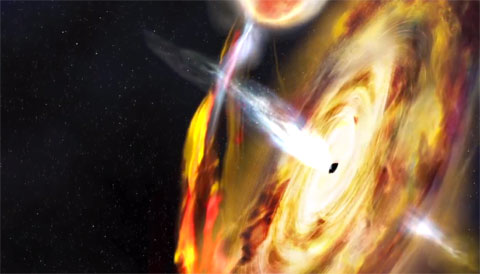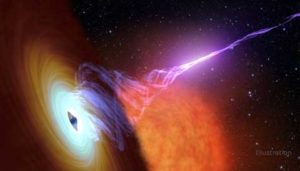Astronomers are taking a cue from bats, using a method similar to echolocation to map out the feeding environment around a black hole.
In March 2018 a stellar-mass black hole went from nearly invisible to the brightest source in the X-ray sky. The sudden burst of activity set off a series of “light echoes,” as the gas feeding the black hole changed shape.

Aurore Simonnet and Nature
Erin Kara (University of Maryland and NASA Goddard) and colleagues report in the January 10th Nature that they have captured these changes in unique observations that unravel a key aspect of black hole growth. Kara also presented the results at last week’s meeting of the American Astronomical Society.
When a Black Hole “Turns On”
Astronomers can study black holes because, while the black holes themselves are almost invisible, the stuff around them isn’t. As a stellar-mass black hole feeds on a companion star, gas swirls inward, heating up to a million degrees and emitting X-rays. Above this accretion disk, charged particles flit about in an even hotter cloud, comprising a billion-degree corona that emits X-rays at much higher energies.
This disk-plus-corona picture sounds complete, but it’s not. In fact, astronomers have no idea what the corona actually looks like; even its basic shape is under debate. Likewise, while the accretion disk is thought to have a (surprise!) disk shape, it remains unclear how far in the disk reaches.
To complicate matters, stellar-mass black holes don’t feed the same way all the time. Sometimes they gobble gas down and sometimes they don’t eat at all. Whenever they switch between these “on” and “off” states, their X-ray emission adjusts in characteristic ways. The disk and corona must be changing shape in the newly discovered system, which had just turned on, but actually imaging these changes is beyond the capability of current and near-future telescopes.
So astronomers employed a different method, watching how light “echoed” in the system. Bats use echolocation to map out surroundings they can’t see, calling out at high frequencies and measuring the time it takes for their calls’ echoes to return. Likewise Kara and colleagues used light echoes to map the unresolvable innards of this suddenly gas-guzzling black hole.
A Rising Star
The team caught the event as it was brightening using an instrument aboard the International Space Station. The Monitor of All-sky X-ray Image (MAXI) acts as a sort of talent scout, surveying the entire X-ray sky every 96 minutes and looking out for variable sources. On March 11th last year, this imager spotted the source now known as MAXI J1820+070 just as it shot up in brightness.
The next day, the Neutron star Interior Composition Explorer (NICER), also aboard the space station, started monitoring the source, looking at it every one to three days. NICER’s detector counted up individual X-ray photons during these observations, measuring their energy and arrival time, even as they flooded in at rates as high as 25,000 photons per second.
Generally speaking, most of the low-energy X-rays come from the disk and most of the high-energy X-rays come from the corona. As data came pouring in from NICER, Kara and colleagues could see that first the high-energy band would brighten or fade, then the low-energy band would follow. The trend suggested that the high-energy radiation coming from the corona was irradiating the disk, heating it up til it glowed at lower energies.

NASA Goddard Space Flight Center
“We noticed that these light echoes got closer and closer together over several weeks,” Kara said. “Something in the system was getting smaller.”
Since other signatures of disk emission weren’t changing over these weeks, Kara’s team figured the change wasn’t happening in the disk. It was the corona that was shrinking, from something like 100 miles across to just 10 miles across.
In fact, a close analysis of the time lags showed that the corona actually appeared to extend vertically above the disk. Such a shape could suggest a connection between the corona and the speedy jets of energetic particles often seen shooting out of these black hole-powered systems.
The idea that the corona may be the base of such jets is still somewhat controversial, though, and coauthor James Steiner (MIT) cautioned that the team’s analysis couldn’t pin down the corona’s exact geometry. “While it’s fair to say a base-of-jet corona could fit neatly with these results, it’s not a unique interpretation either,” he added.

NASA / JPL-Caltech
The results also offer an ant’s-eye view of a process that occurs on elephantine scales in supermassive black holes. While a stellar-mass black hole may “turn on” in a matter of days or months, the supermassive black holes at the centers of distant galaxies can take tens of thousands of years to make the same kind of transition.
“[This measurement] adds a valuable piece to the puzzle, but this event represents only a single data point,” says Daryl Haggard (McGill University, Canada), the author of an opinion piece accompanying the Nature article. Haggard adds that the study of additional stellar-mass black holes, as well as supermassive black holes with irregular feeding habits would help strengthen these findings.
 2
2









Comments
Anthony Barreiro
January 16, 2019 at 3:09 pm
This is a really interesting report, and Kara's video is quite informative.
From its coordinates MAXI J1820+070 is in eastern Ophiuchus, near the border with Serpens Cauda. An internet search yielded a distance of 3.2 kpc or 10,400 light years. Somehow I always want to know where these strange beasts are in the sky, and how far away they are.
And, by the way, it's a shame that Dr. Kara and all the other fine scientists, engineers, and technicians at NASA are unable to do their jobs during the government shutdown. We'll give them retroactive pay once they're back to work. It's a stupendous waste of human potential and taxpayer money.
You must be logged in to post a comment.
Lou
January 22, 2019 at 1:38 pm
Hey, did JPL get permission from S&T before using Camille Carlisle's profile picture? ;o)
You must be logged in to post a comment.
You must be logged in to post a comment.